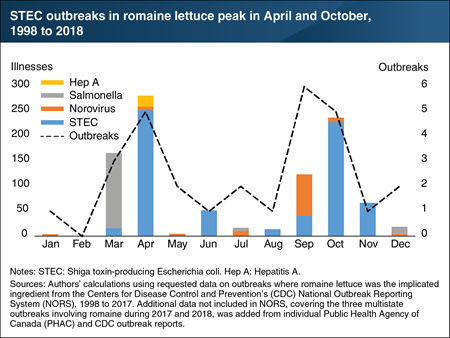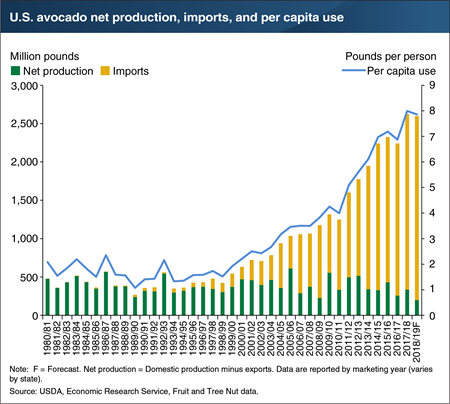Editors' Pick: Charts of Note 2019
This chart gallery is a collection of some of the best Charts of Note from 2019. These charts were selected by ERS editors as those worthy of a second read because they provide context for the year’s headlines or share key insights from ERS research.

Monday, December 2, 2019
Leafy greens, including romaine lettuce, are the sixth most commonly consumed type of vegetable in the United States. About three-quarters of U.S. romaine shipments come from two regions, California’s Central Coast and Yuma, Arizona; the rest come from other areas in the United States, Mexico, and Canada. From May to November, about three-quarters of romaine lettuce shipments in the United States come from California’s Central Coast region, while from December to April, about three-quarters come from the Yuma, Arizona region. From 1998 to 2018, foodborne illnesses and outbreaks associated with romaine lettuce occurred most frequently during March, April, September, and October—the time of the season prior to shifts in regional production. In 2017 and 2018 there were three multi-state, multi-national foodborne illness outbreaks of Shiga toxin-producing Escherichia coli (STEC) O157:H7 associated with the consumption of romaine lettuce in the U.S. and Canada. These outbreaks led to a total of 376 illnesses, 158 hospitalizations, and 7 deaths. This chart appears in “Special Article: Seasonality in Romaine Outbreaks and Regional Shipments” in the Vegetables and Pulses Outlook newsletter, released in May 2019.

Wednesday, April 24, 2019
Imports play a significant role in meeting the U.S. demand for avocados. Since the mid-1990s, imports of avocados have grown sharply as per capita consumption has grown, representing 87 percent of domestic use in the 2017/18 marketing year. USDA forecasts that imports will make up an even larger share of supply in 2018/19, mainly because California’s crop is expected to be smaller than in recent years. Contributing factors to this reduced crop include record-breaking heatwaves in July 2018 followed by record-breaking wildfires, as well as recent rains and cold weather, and the general alternate-year-bearing nature of avocado trees (whereby a large crop one year is followed by a smaller crop the next year). Because over 80 percent of all U.S.-produced avocados each year are from California, California’s low harvest in 2018/19 should boost U.S. demand for imported avocados (especially from Mexico) even higher than it has been in recent years. If USDA’s forecast is realized, imports in 2018/19 will represent 93 percent of the domestic avocado supply. This chart appears in the ERS Fruit and Tree Nuts Outlook newsletter, released in March 2019.

